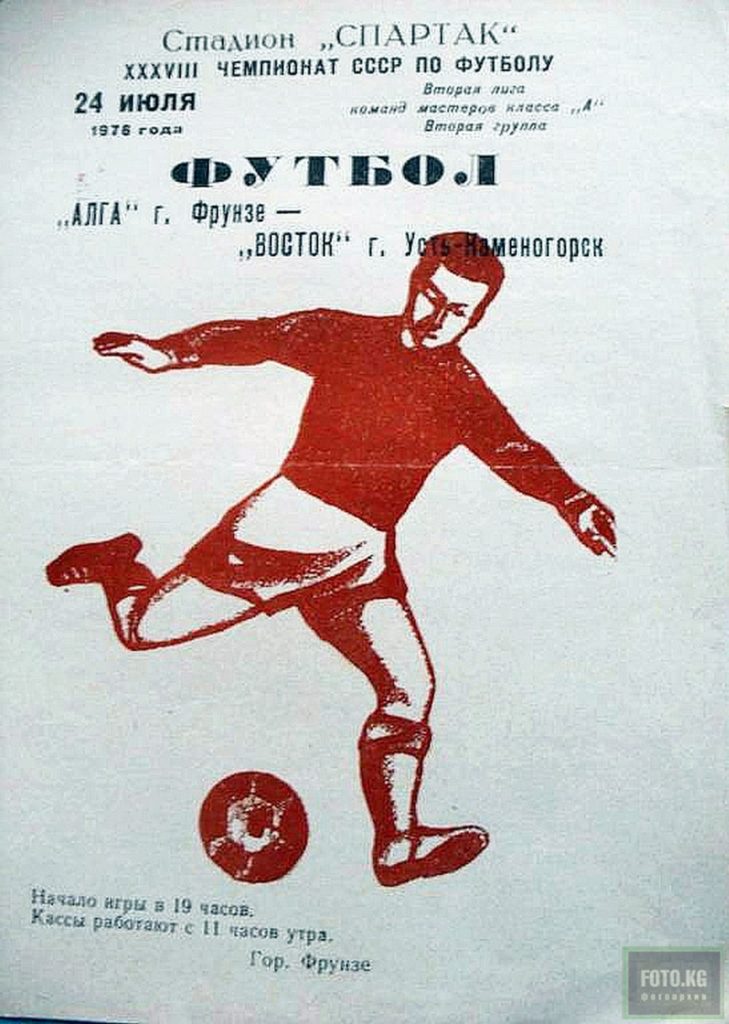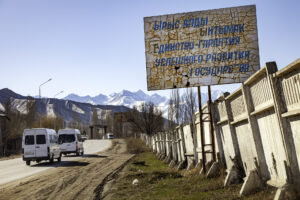The Kyrgyz Football Federation celebrated 100 years on 21 March 2021, but it’s as active as ever. Novastan looks back at the game’s history in the Central Asian nation.
This article was originally published on Novastan’s French website on 21 March 2021.
As the Union of Kyrgyz Football (UKF) notes on Twitter, its very first kick off happened a hundred years ago, on 21 March 1921, in Pishpek, the capital of Kyrgyzstan now known as Bishkek. The occasion was a match between a local team and opponents from Verny in Kazakhstan, today’s Almaty.
The game ended with a 3-1 score for the visiting team, though the names of the scorers and indeed of any of the participants are unknown. “For a whole century of football history, many masters have brought glory to national football, have become an example for young players,” the UKF wrote.
Second-class in Soviet times
The beginnings were rather slow, however. The first football clubs of Soviet Kirghizia were founded in the 1930s in Frunze, another former name for Bishkek. One of the capital’s first teams won the first local championship in 1934. In an article about the sport’s history, the Kyrgyz website sport.kg notes that football could not really develop in the 1920s and 1930s due to a lack of infrastructure.

“Strange though it may seem, World War Two played a huge role in the development of football in Kyrgyzstan,” the article explains. Indeed, with the evacuation of workers from the west of the Soviet Union came a large number of sports fans. Local teams such as Alga Frunze and Alay Osh, founded in 1967 in Osh, Kyrgyzstan’s second-largest city, were able to reach high Soviet divisions.
But, as Futbolgrad, a website dedicated to post-Soviet football, notes, the Kirghiz Soviet Socialist Republic (Kirghiz SSR) is one of only two republics to never reach the Soviet Top League, the other being Turkmenistan. Alga Frunze nearly qualified in 1967, when it finished third in the First League, the second highest division. In the final years of the Soviet Union, Alga Frunze and Alay Osh both played in the third division.
A difficult path since independence
In the early 1990s, the Kirghiz SSR became the Republic of Kyrgyzstan, Frunze became Bishkek and, on 31 August 1991, the country declared its independence. The Football Federation of the Kyrgyz Republic was founded six months later, in February 1992, and joined FIFA and the Asian Football Confederation (AFC) in 1994. It has been known as the Kyrgyz Football Union since 2020.
A Kyrgyz championship was soon fought by short-lived teams such as Kant-Oil, which existed for three seasons and won two national championships in the 1990s, and historic teams. Alga Frunze, renamed Alga Bishkek, for example, was the best Kyrgyz club in Soviet times but has not won a single national championship since the early 2000s. Later on, the national championship is dominated by Dordoy Dinamo Naryn, undisputed champion between 2004 and 2099, and its successor Dordoy Bishkek from 2010.
Dordoy Bishkek came top of the national championship six times between 2011 and 2020. Funds for the club come from the Dordoy group, which owns the bazar of the same name on the outskirts of Bishkek. Alay Osh has also made a comeback in recent years, with four titles since 2010.

More generally, football in Kyrgyzstan suffers from a lack of funds, with the consequences described by Futbolgrad in 2013: games at 4pm on weekdays to avoid a floodlight charge, players who can’t swap jerseys at the end of a friendly game… Such issues have hindered the development of the country’s first division, known internationally as the Kyrgyz Premier League.
As the then president of the Federation of Kyrgyz Football Semetey Sultanov told the Kyrgyz branch of the American RFE/RL, Radio Azattyk, in 2015, the sport gets hardly any public funding: “The Federation’s budget is 250,000 dollars from FIFA per year. It does not get a single som from Kyrgyztan’s budget.” The national team’s situation is similar, despite players leaving the country for lack of opportunities, sometimes even changing nationalities. Kazakhstan, for instance, has recruited several Kyrgyz players.
Little international results for clubs
All this explains why Kyrgyz football has not found success on the international stage. Kyrgyz clubs struggle to reach the group stage in the AFC Champions League, an annual club competition organised by the AFC. In contrast, all other Central Asian states have qualified, apart from Kazakhstan, which is not an AFC member.
Here again lack of funds is an issue.“Kyrgyz football is not monetized and sold as a product,” the sports journalist Adilet Temirlanov told Azattyk in August 2020. “Football marketing should also be developed in Kyrgyzstan. Clubs would then not experience such financial difficulties.” He added that no football club in Kyrgyzstan makes a profit.
The story is different for the national team. The “White Falcons” have achieved what local clubs could not: look for success and inspiration abroad, a huge challenge for a team which between 1991 and 2011 had not played more than 38 matches. What’s more, it had only won 26.3% of those games. It was not until 2016 that Kyrgyzstan won against a neighbouring country, when it played a friendly match against Kazakhstan.
More surprising, in 2006 the national team took part in the ELF Cup, a one-time competition for teams not recognised internationally, such as those of Tibet or North Cyprus. It came in third.
The only hope for Kyrgyz football at the time was the national futsal team, which finished third in the Asian Championship in 2005, a feat they have yet to repeat.
Picking up steam
Faced with this lack of success, the federation looked for help abroad: the national team hired the Russian manager Sergey Dvoryankov (2012-2014) and Aleksandr Krestinin (since 2014). The latter, who also manages Dordoy Bishkek since 2017, has pushed the federation to recruit players overseas. For example, the team now comprises German players born in Kyrgyzstan such as Vitalij Lux and Edgar Bernhardt but also footballers from Ghana such as Daniel Tagoe and Elijah Ari.
As the Kyrgyz media Kaktus notes, Kyrgyzstan’s men’s national football team has moved up in the FIFA ranking since the 2010s. If it hovered around the 200th place at the start of the decade, it reached the top 100 in 2018 and is currently in 98th position
Testifying to these improvements is the national team’s performance during the 2018 World Cup qualification process. It played well against Asian Cup champion Australia and defeated Jordan, a more prestigious team. The White Falcons even reached the knockout stage in the 2019 AFC Asian Cup, losing 2-3 in overtime against the UAE. This is the national selection’s greatest achievement to date. Currently it is in third position in its group for the 2022 Word Cup qualification.
The women’s team, currently in 111th position in world rankings, has attracted even less attention. However, player Aidana Otorbaeva was recently named a “hero” by the Federation of Professional Players’ Association (FIFPRO) for her volunteering work during the Covid-19 pandemic.
Clément Clerc-Dubois
Novastan.org
Translated from French by Valentine Baldassari
 A hundred years of Kyrgyz football
A hundred years of Kyrgyz football 



